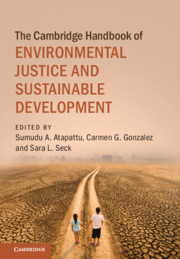Book contents
- The Cambridge Handbook of Environmental Justice and Sustainable Development
- The Cambridge Handbook of Environmental Justice and Sustainable Development
- Copyright page
- Contents
- Contributors
- Acknowledgments
- Foreword (on Living in an Interregnum)
- 1 Intersections of Environmental Justice and Sustainable Development
- Part I Frameworks
- Part II Case Studies
- Strategies, Challenges, and Vulnerable Groups
- Toxic Substances and Hazardous Wastes
- Resource Extraction
- Energy
- Climate Change
- 26 Climate Justice and the Social Pillar in California’s Climate Policies
- 27 Climate Change–Related Ecohealth Considerations for Impact Assessments in the Canadian Arctic
- 28 Climate Justice, Sustainable Development, and Small Island States
- Part III Conclusion
- Index
27 - Climate Change–Related Ecohealth Considerations for Impact Assessments in the Canadian Arctic
from Climate Change
Published online by Cambridge University Press: 26 March 2021
- The Cambridge Handbook of Environmental Justice and Sustainable Development
- The Cambridge Handbook of Environmental Justice and Sustainable Development
- Copyright page
- Contents
- Contributors
- Acknowledgments
- Foreword (on Living in an Interregnum)
- 1 Intersections of Environmental Justice and Sustainable Development
- Part I Frameworks
- Part II Case Studies
- Strategies, Challenges, and Vulnerable Groups
- Toxic Substances and Hazardous Wastes
- Resource Extraction
- Energy
- Climate Change
- 26 Climate Justice and the Social Pillar in California’s Climate Policies
- 27 Climate Change–Related Ecohealth Considerations for Impact Assessments in the Canadian Arctic
- 28 Climate Justice, Sustainable Development, and Small Island States
- Part III Conclusion
- Index
Summary
Climate change is affecting the Arctic faster and more severely than other parts of the world. Arctic temperatures are rising at over twice the global rate, and it is predicted that the Arctic Ocean could be largely free of summer ice by the late 2030s.1 Scientists warn that increasing concentrations of greenhouse gases in the atmosphere are now impacting the Arctic’s climate, hydrological, and ecological systems to such an extent that the region is actually “shifting to a new state” – “the Arctic as we know it is being replaced by a warmer, wetter, and more variable environment”2 with “profound implications for people, resources, and ecosystems worldwide.”3
- Type
- Chapter
- Information
- Publisher: Cambridge University PressPrint publication year: 2021

